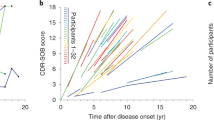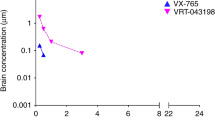Abstract
Cancer and Alzheimer's disease (AD) are commonly found among elderly patients. Chronic inflammation is the characteristic of both diseases. Amyloid-β peptide is the main inducer of inflammation in AD. Moreover, chronic inflammation promotes cancer, suggesting that AD patients may be more prone to develop cancer than non-demented people. To test this hypothesis, we injected the carcinogen 20-methylcholanthrene in the brain of transgenic mice overexpressing the mutant forms of amyloid precursor protein (APP) and presenilin 1 (PS1), as a model of AD, and their wild-type (WT) littermates. Mutant mice developed tumors faster and with higher incidence than their WT counterparts. Expression of the inflammatory markers interleukin (IL)-1α, IL-1β, IL-6, IP-10 and tumor necrosis factor-α (TNF-α) was measured in AD and WT mice of 3 and 12 months of age that had not been exposed to the carcinogen. These cytokines were elevated in older AD mice, indicating the existence of a highly inflammatory milieu in these animals. We also found elevated expression of a mutated form of p53 in older AD mice, suggesting an alternative mechanism for the predisposition of AD brains to develop brain tumors. Clinical studies reporting comorbidity of AD and brain cancer are needed to understand whether our observations hold true for humans.
This is a preview of subscription content, access via your institution
Access options
Subscribe to this journal
Receive 50 print issues and online access
$259.00 per year
only $5.18 per issue
Buy this article
- Purchase on Springer Link
- Instant access to full article PDF
Prices may be subject to local taxes which are calculated during checkout



Similar content being viewed by others
References
Anisimov VN . (2007). Biology of aging and cancer. Cancer Control 14: 23–31.
Apte RN, Dotan S, Elkabets M, White MR, Reich E, Carmi Y et al. (2006). The involvement of IL-1 in tumorigenesis, tumor invasiveness, metastasis and tumor-host interactions. Cancer Metastasis Rev 25: 387–408.
Beard CM, Kokmen E, Sigler C, Smith GE, Petterson T, O′Brien PC . (1996). Cause of death in Alzheimer's disease. Ann Epidemiol 6: 195–200.
Borchelt DR, Ratovitski T, van LJ, Lee MK, Gonzales V, Jenkins NA et al. (1997). Accelerated amyloid deposition in the brains of transgenic mice coexpressing mutant presenilin 1 and amyloid precursor proteins. Neuron 19: 939–945.
Chang CY, Li MC, Liao SL, Huang YL, Shen CC, Pan HC . (2005). Prognostic and clinical implication of IL-6 expression in glioblastoma multiforme. J Clin Neurosci 12: 930–933.
Chicoine MR, Silbergeld DL . (1997). Mitogens as motogens. J Neurooncol 35: 249–257.
Chu GC, Kimmelman AC, Hezel AF, DePinho RA . (2007). Stromal biology of pancreatic cancer. J Cell Biochem 101: 887–907.
Correa P, Houghton J . (2007). Carcinogenesis of Helicobacter pylori. Gastroenterology 133: 659–672.
Coussens LM, Werb Z . (2002). Inflammation and cancer. Nature 420: 860–867.
Di DF, Cenini G, Sultana R, Perluigi M, Uberti D, Memo M et al. (2009). Glutathionylation of the pro-apoptotic protein p53 in Alzheimer's disease brain: implications for AD pathogenesis. Neurochem Res 34: 727–733.
Driver JA, Djousse L, Logroscino G, Gaziano JM, Kurth T . (2008). Incidence of cardiovascular disease and cancer in advanced age: prospective cohort study. BMJ 337: a2467.
Duff K, Eckman C, Zehr C, Yu X, Prada CM, Perez-tur J et al. (1996). Increased amyloid-beta42(43) in brains of mice expressing mutant presenilin 1. Nature 383: 710–713.
Formiga F, Fort I, Robles MJ, Barranco E, Espinosa MC, Riu S . (2007). Medical comorbidity in elderly patients with dementia. Differences according age and gender. Rev Clin Esp 207: 495–500.
Formiga F, Fort I, Robles MJ, Riu S, Rodriguez D, Sabartes O . (2008). Features differentiating comorbidity in elderly patients with Alzheimer-type dementia or with vascular dementia. Rev Neurol 46: 72–76.
Gambassi G, Lapane KL, Landi F, Sgadari A, Mor V, Bernabie R . (1999). Gender differences in the relation between comorbidity and mortality of patients with Alzheimer's disease. Systematic assessment of geriatric drug use via epidemiology (SAGE) study group. Neurology 53: 508–516.
Gasper MC, Ott BR, Lapane KL . (2005). Is donepezil therapy associated with reduced mortality in nursing home residents with dementia? Am J Geriatr Pharmacother 3: 1–7.
Giunta B, Fernandez F, Nikolic WV, Obregon D, Rrapo E, Town T et al. (2008). Inflammaging as a prodrome to Alzheimer's disease. J Neuroinflammation 5: 51.
Griffin RJ, Moloney A, Kelliher M, Johnston JA, Ravid R, Dockery P et al. (2005). Activation of Akt/PKB, increased phosphorylation of Akt substrates and loss and altered distribution of Akt and PTEN are features of Alzheimer's disease pathology. J Neurochem 93: 105–117.
Harikumar KB, Aggarwal BB . (2008). Resveratrol: a multitargeted agent for age-associated chronic diseases. Cell Cycle 7: 1020–1035.
Hong SH, Ondrey FG, Avis IM, Chen Z, Loukinova E, Cavanaugh Jr PF et al. (2000). Cyclooxygenase regulates human oropharyngeal carcinomas via the proinflammatory cytokine IL-6: a general role for inflammation? FASEB J 14: 1499–1507.
Hoozemans JJ, Rozemuller JM, van Haastert ES, Veerhuis R, Eikelenboom P . (2008). Cyclooxygenase-1 and -2 in the different stages of Alzheimer's disease pathology. Curr Pharm Des 14: 1419–1427.
Hsiao K, Chapman P, Nilsen S, Eckman C, Harigaya Y, Younkin S et al. (1996). Correlative memory deficits, Abeta elevation, and amyloid plaques in transgenic mice. Science 274: 99–102.
Hu M, Polyak K . (2008). Molecular characterisation of the tumour microenvironment in breast cancer. Eur J Cancer 44: 2760–2765.
Hussain SP, Hofseth LJ, Harris CC . (2003). Radical causes of cancer. Nat Rev Cancer 3: 276–285.
Kamer AR, Dasanayake AP, Craig RG, Glodzik-Sobanska L, Bry M, de Leon MJ . (2008). Alzheimer's disease and peripheral infections: the possible contribution from periodontal infections, model and hypothesis. J Alzheimers Dis 13: 437–449.
Kim S, Takahashi H, Lin WW, Descargues P, Grivennikov S, Kim Y et al. (2009). Carcinoma-produced factors activate myeloid cells through TLR2 to stimulate metastasis. Nature 457: 102–106.
Lanni C, Racchi M, Uberti D, Mazzini G, Stanga S, Sinforiani E et al. (2008). Pharmacogenetics and pharmagenomics, trends in normal and pathological aging studies: focus on p53. Curr Pharm Des 14: 2665–2671.
Leonard BE . (2007). Inflammation, depression and dementia: are they connected? Neurochem Res 32: 1749–1756.
Mbeunkui F, Johann Jr DJ . (2009). Cancer and the tumor microenvironment: a review of an essential relationship. Cancer Chemother Pharmacol 63: 571–582.
Murat A, Migliavacca E, Hussain SF, Heimberger AB, Desbaillets I, Hamou MF et al. (2009). Modulation of angiogenic and inflammatory response in glioblastoma by hypoxia. PLoS ONE 4: e5947.
Nelson JS . (2002). Alzheimer pathology in elderly patients with glioblastoma multiforme. Arch Pathol Lab Med 126: 1515–1517.
Paugh BS, Bryan L, Paugh SW, Wilczynska KM, Alvarez SM, Singh SK et al. (2009). Interleukin-I regulates the expression of sphingosine Kinase I in glioblastoma cells. J Biol Chem 284: 3408–3417.
Peebles KA, Lee JM, Mao JT, Hazra S, Reckamp KL, Krysan K et al. (2007). Inflammation and lung carcinogenesis: applying findings in prevention and treatment. Expert Rev Anticancer Ther 7: 1405–1421.
Psaila B, Lyden D . (2009). The metastatic niche: adapting the foreign soil. Nat Rev Cancer 9: 285–293.
Quante M, Wang TC . (2008). Inflammation and stem cells in gastrointestinal carcinogenesis. Physiology (Bethesda) 23: 350–359.
Ribatti D, Mangialardi G, Vacca A . (2006). Stephen Paget and the ‘seed and soil’ theory of metastatic dissemination. Clin Exp Med 6: 145–149.
Rodrigo J, Fernandez-Vizarra P, Castro-Blanco S, Bentura ML, Nieto M, Gomez-Isla T et al. (2004). Nitric oxide in the cerebral cortex of amyloid-precursor protein (SW) Tg2576 transgenic mice. Neuroscience 128: 73–89.
Roe CM, Behrens MI, Xiong C, Miller JP, Morris JC . (2005). Alzheimer disease and cancer. Neurology 64: 895–898.
Rogers J . (2008). The inflammatory response in Alzheimer's disease. J Periodontol 79: 1535–1543.
Saetre P, Emilsson L, Axelsson E, Kreuger J, Lindholm E, Jazin E . (2007). Inflammation-related genes up-regulated in schizophrenia brains. BMC Psychiatry 7: 46.
Salminen A, Ojala J, Kauppinen A, Kaarniranta K, Suuronen T . (2009). Inflammation in Alzheimer's disease: amyloid-beta oligomers trigger innate immunity defence via pattern recognition receptors. Prog Neurobiol 87: 181–194.
Sanders P, De KJ . (2007). Janus faces of microglia in multiple sclerosis. Brain Res Rev 54: 274–285.
Sastre M, Walter J, Gentleman SM . (2008). Interactions between APP secretases and inflammatory mediators. J Neuroinflammation 5: 25.
Serrano J, Fernandez AP, Sanchez J, Rodrigo J, Martinez A . (2008). Adrenomedullin expression is up-regulated by acute hypobaric hypoxia in the cerebral cortex of the adult rat. Brain Pathol 18: 434–442.
Steinman L . (2008). Nuanced roles of cytokines in three major human brain disorders. J Clin Invest 118: 3557–3563.
Stock D, Groome PA, Siemens DR . (2008). Inflammation and prostate cancer: a future target for prevention and therapy? Urol Clin North Am 35: 117–130.
Stolt CC, Lommes P, Sock E, Chaboissier MC, Schedl A, Wegner M . (2003). The Sox9 transcription factor determines glial fate choice in the developing spinal cord. Genes Dev 17: 1677–1689.
Tansey MG, Frank-Cannon TC, McCoy MK, Lee JK, Martinez TN, McAlpine FE et al. (2008). Neuroinflammation in Parkinson's disease: is there sufficient evidence for mechanism-based interventional therapy? Front Biosci 13: 709–717.
Uberti D, Lanni C, Racchi M, Govoni S, Memo M . (2008). Conformationally altered p53: a putative peripheral marker for Alzheimer's disease. Neurodegener Dis 5: 209–211.
Vesce S, Rossi D, Brambilla L, Volterra A . (2007). Glutamate release from astrocytes in physiological conditions and in neurodegenerative disorders characterized by neuroinflammation. Int Rev Neurobiol 82: 57–71.
Wang Y, Yang J, Zheng H, Tomasek GJ, Zhang P, McKeever PE et al. (2009). Expression of mutant p53 proteins implicates a lineage relationship between neural stem cells and malignant astrocytic glioma in a murine model. Cancer Cell 15: 514–526.
Yamada M, Sasaki H, Mimori Y, Kasagi F, Sudoh S, Ikeda J et al. (1999). Prevalence and risks of dementia in the Japanese population: RERF′s adult health study Hiroshima subjects. Radiation Effects Research Foundation. J Am Geriatr Soc 47: 189–195.
Yeruva S, Ramadori G, Raddatz D . (2008). NF-kappaB-dependent synergistic regulation of CXCL10 gene expression by IL-1beta and IFN-gamma in human intestinal epithelial cell lines. Int J Colorectal Dis 23: 305–317.
Zimmerman H, Arnold H . (1941). Experimental brain tumors. I. Tumors produced with methylcholantrene. Cancer Res 1: 919–938.
Acknowledgements
We gratefully acknowledge Professor Ignacio Torres (Instituto Cajal, Madrid, Spain) for the breeding pairs to initiate the mouse colony. We are also grateful to Dr Josune García-Sanmartín (CIBIR, Logroño, Spain) for her valuable help in statistical analysis. This work was supported by Spanish Ministry of Science and Innovation Grant SAF2007-60010, and Instituto de Salud Carlos III Grant RD06/0026/1001.
Author information
Authors and Affiliations
Corresponding author
Ethics declarations
Competing interests
The authors declare no conflict of interest.
Rights and permissions
About this article
Cite this article
Serrano, J., Fernández, A., Martínez-Murillo, R. et al. High sensitivity to carcinogens in the brain of a mouse model of Alzheimer's disease. Oncogene 29, 2165–2171 (2010). https://doi.org/10.1038/onc.2009.503
Received:
Revised:
Accepted:
Published:
Issue Date:
DOI: https://doi.org/10.1038/onc.2009.503
Keywords
This article is cited by
-
A molecular hypothesis to explain direct and inverse co-morbidities between Alzheimer’s Disease, Glioblastoma and Lung cancer
Scientific Reports (2017)
-
Plasma Amyloid-Beta Levels in Patients with Different Types of Cancer
Neurotoxicity Research (2017)
-
Loss of presenilin 2 is associated with increased iPLA2 activity and lung tumor development
Oncogene (2014)
-
Conformational altered p53 affects neuronal function: relevance for the response to toxic insult and growth-associated protein 43 expression
Cell Death & Disease (2013)



